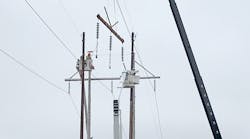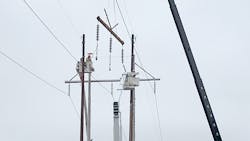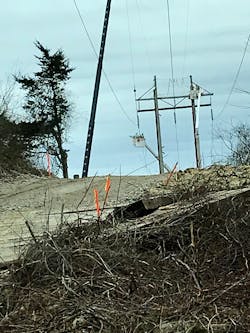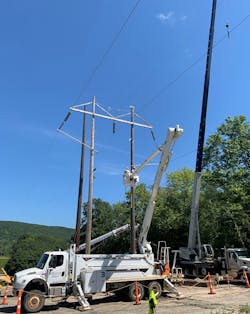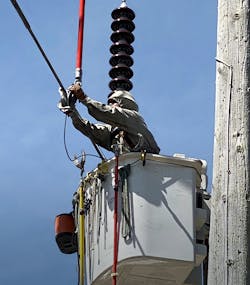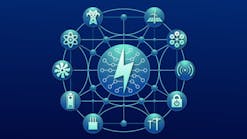Contractor Trains Crews on Live-Line Work Methods
The increasing power flow congestion on transmission lines is magnifying the need for more live-line work. Before diving into this work method, however, utilities and line contractors must train their crews to safely work barehand or perform hot-stick work.
“Bare-hand work is clean, and each day you’re going from structure to structure, so the pace is constant,” says Joshua Magoon, superintendent for Three Phase Line Construction, a Rochester, New Hampshire-based contractor. “By comparison, distribution work is on a smaller scale and closer to the ground. Live-line work is a specialty job in a dangerous world that not everyone is certified to do.”
For example, Three Phase Line Construction has certified its crews to perform live-line work for its clientele. Recently, by working barehand, Three Phase Line Construction’s linemen swapped out more than a dozen wooden H-frame transmission structures with steel towers varying in height from 60 ft to 100 ft near Stonington, Connecticut. Eversource hired the contractor to address the aging structures and damage caused by weather and wildlife on a 115-kV line.
After Three Phase Line completed the project in January for Eversource, the firm began several other bare-hand projects ranging in voltage from 115-kV to 345-kV across Connecticut.
Training Crews
Prior to its projects in Connecticut for Eversource, Three Phase Line Construction had completed several years of bare-hand work in New York State. About 10 years ago, Matt Ripley, a superintendent for Three Phase Line in New York, and his coworkers developed the company’s live-line training curriculum and procedures. With the foundation Ripley built, Magoon and a third-party instructor certified Three Phase Line’s crews in Connecticut and developed a train-the-trainer program for annual recertifications in accordance with the Occupational Safety and Health Administration (OSHA).
Three Phase Line’s program includes not only written material but also an intense, on-the-job component that Magoon and his coworkers view as indispensable. The training covers inspecting bare-hand vehicles, equipment and how to monitor crews in the air. Some utilities have even asked Three Phase Line to come on site for an evaluation to demonstrate everything from their tailboards and hazard analysis to testing vehicles and evaluating crane operators and groundmen.
“Trust is such a big part of live-line work,” says Chuck Fontenault, senior director of Operations for T&D Power, an extra high voltage (EHV) construction company and sister organization to Three Phase Line Construction. “You can be qualified to do this work, but you have to win the trust of the people you’re working with – that’s the final test.”
Before passing that final “trust exam,” qualified line workers who come to Three Phase Line to be bare-hand workers spend three weeks or more immersing themselves in a combination of live-line theory, practical applications and supervised on-the-job training. Every aspect of the training—from changing marking balls and vibration dampers to bonding on and off a conductor and rigging theory—has a written work-practice according to Magoon. The practical work includes trainees learning: the dos and don’ts of figuring loads they’re picking; the effects of span lengths when picking up a conductor from an angle versus a straight-line pick; proper inspection and care of bare-hand suits; and calculating the different microamps for the type of voltage to prevent a catastrophic accident.
Linemen are also trained to maintain and inspect both their trucks and their tools.
High-risk work like this might cause some to think it is critically important to have the newest, latest-model equipment. “Having the newest equipment matters but you have to be fanatical about maintaining and inspecting it,” Magoon says.
According to Magoon, a bare-hand truck requires inspection every day to make sure the tool hasn’t been compromised. All insulated tools have a specified frequency of inspection requiring the tool to be electronically tested for integrity, cataloged and tracked.
“You could have a 10-year-old truck and if the boom is clean and passes tests daily, then you can work safely,” he says.
Working Live
When utilities call on companies like Three Phase Line to take on live-line work, projects vary from simple maintenance like replacing cracked insulators to complete upgrades that include setting new structures and transferring conductors from old to new ones. For example, the contractor recently replaced aging, 60-ft-tall wooden structures on a 69-kV transmission line. The line was a radial feed to a substation, which made it necessary to work on an energized line; taking down the substation would interrupt power to all the customers.
Because the conductors were in good shape, according to the utility, Three Phase Line drilled holes for the new, 90-ft-high steel structures and set the towers and insulators at a distance to accommodate a 115-kV line. Three Phase Line built the new structures that not only mitigated existing issues, but also added additional hardening to improve system reliability. Three Phase Line’s crews used cranes to pick and move the conductors and drop them into travelers at which point the line crews secured the conductors.
Utility and contract crews can tackle live-line work up to 500-kV, but voltage isn’t their only concern. They must also account for the current flow. Although high voltage is always something to be acutely aware of, even one-tenth of an ampere can place a heart in fibrillation.
One determining factor for what style of line-line work a crew undertakes would be the minimum approachable distance (MAD). If a crew is qualified, then workers can employ the bare-hand method up to 500-kV.
With bare-hand projects, the line crews work on the energized conductor and become part of the circuit, field and wire all as one. If crews cannot safely perform bare-hand work, then a crew will turn to a live-line method such as hot-sticking to keep the MAD.
The fiberglass tools keep the workers at the MAD for that conductor or energized system. According to Three Phase Line’s experts, certain states don’t allow bare-hand work. For instance, in Colorado, crews rely on hot sticking.
The Payoff of Live Line Work
While quality pay, excitement and bragging rights all have a certain appeal, live-line certified contractors know the work saves their customers money, especially when those companies have hundreds of thousands, sometimes millions, of consumers as well as major corporations depending on uninterrupted electricity. Any outage runs the risk of financially affecting utility customers.
While working on energized lines is more involved and presents a heightened hazard, crews that efficiently and safely carry out live-line work can, potentially, save a utility penalties and financial costs totaling tens to hundreds of thousands of dollars or more.
Bill Perry ([email protected]) is a New York-based freelance writer who has covered the utility, manufacturing and aerospace and defense industries for more than 20 years.
